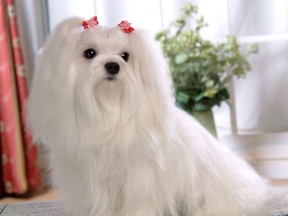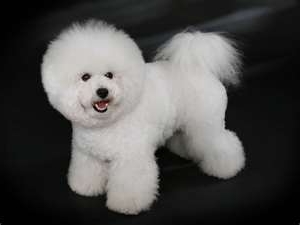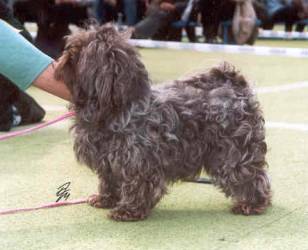Related breeds
The Havanese breed descends from old-world Bichon types of small companion dogs such as antique versions of the Maltese and the Caniche. They are neither Spaniels nor Terriers. This group of small longhaired dogs is very old and originated in the Mediterranean in pre-Christian times. From the original antique "small dog", numerous varieties evolved. As the centuries passed, interesting variations developed into separate and distinct breeds, each with a slightly different temperament and appearance. Variations, in large part arose from the preferences of their human caretakers of the time, climactic influence as well as possible input from other breeds. The Havanese breed is part of the Bichon family: a group of small, long-haired, drop-eared companion dogs which includes the Bichon Frise, Coton de Tulear, Bolognese, Maltese, Bolonka, and perhaps the Lowchen.
Maltese

Bichon Frise

Bolognese

Coton de Tulear

Lowchen

Tvetnaya Bolonka

Maltese: Phoenician traders probably brought this ancient breed to Malta more than 2000 years ago. The Maltese of today is a very sweet-natured, good-tempered, lively little dog that is full of fun. Much of it's physical appeal comes from the stark contrast of large dark eyes and a black button nose set off against an immaculate floor-sweeping pure white silky coat. The coat was not always white though. His history does have references to coloured dogs as can be seen here in a Maltese Breed History
Bichon Frise: This breed originated in the Mediterranean in the middle ages. By the 14th century, sailors had introduced it to the island of Tenerife, and by the 15th century it was a royal favourite.
The Bichon Frise is a small, sturdy powder puff of a dog with a merry, happy-go-lucky temperament. Masses of pure white, soft corkscrew ringlets provide the perfect backdrop for it's dark almond eyes and jet black nose. He is a very happy, lively, bouncy companion. When people talk of the "Bichon", this is usually the breed they mean.
Bolognese: Though perhaps developed in Southern Italy, this breed takes it's name from the northern Italian city of Bologna where it was especially popular. Descriptions have been recorded since the 1200's. As other Bichons, The Bolognese served a role of companion among the ruling families and aristocracy of Renaissance Italy. Its stocky, compact body is covered with a soft white cottony curly coat. He is very sweet, affectionate and devoted to its family. Alhough some references indicate that the Bolognese may be somewhat serious little dogs, slightly docile and shy, many are quite lively and vivacious.
Coton de Tulear: Related to the french Bichons, and the Italian Bolognese, the Coton arrived in Madagascar in the 1600's with french troops or with the administrators that followed. There it developed into a distinct breed. For centuries it was the favoured companion of the wealthy residents of Tulear in Southern Madagascar. It is often known as the " Royal Dog of Madagascar". The Coton is covered with a light-textured cotton-candy fluffy white coat. Unlike it's all-white European cousins, the Coton may have lemon or black patches or tipping, though these often fade at maturity.
The Lowchen is often referred to as "The Little Lion Dog" because of its traditional clip that gives the dog the appearance of a small lion. The coat comes in an assortment of colours. The modern Lowchen is the enigma of the Bichon family. Alhough it does exhibit some of the typical Bichon traits, a number of other characteristics are unique to the Lowchen and not found in any of the other related breeds. The square body, semi-harsh outer coat and spunky boisterous nature seem to suggest a degree of terrier influence.
Bolonka: This rarest of the bichon breeds originated in East Germany and Poland and was subsequently developed in Russia. Bolonka means "small dog". Tsvetnaya means "colored". It comes in a variety of colours except white. In appearance, and temperament, the Tsvetnaya Bolonka is somewhat similar to the Havanese. In size, it is more like the Maltese, weighing just 3 to 6 pounds.
